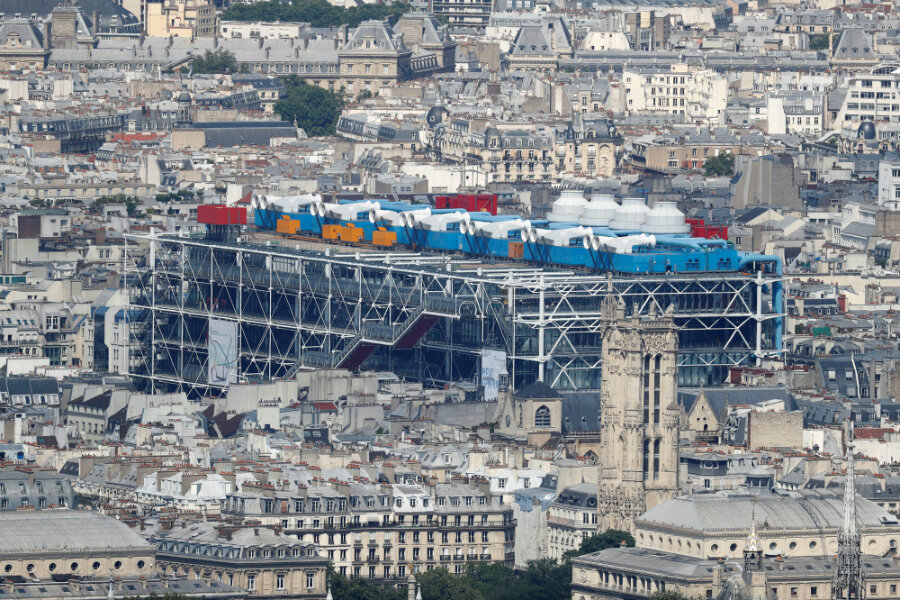The Pompidou at 40: How, despite terrorism, museum keeps Parisians coming
Loading...
| CENTRE POMPIDOU, PARIS
Upon its inauguration in January 1977, France’s leading newspaper Le Monde called it the “rape” of Paris. Le Figaro declared that the city now had its own “Loch Ness monster.”
The Centre Pompidou, the modern art museum whose façade of blue and green tubing rises above the historic rooftops of Paris, was once so panned that even artists balked at putting their works in a venue they said resembled a “supermarket.”
Now as it celebrates its 40th anniversary, it not only boasts one of the biggest collections of contemporary art in the world, it is also deeply loved – and nowhere more so than in its backyard.
While the Louvre and the Musée d’Orsay reported declines in visitors in 2016, after terrorist attacks in 2015 scared off foreign tourists, the Pompidou saw a 9 percent increase in attendance. That is mostly thanks to its French visitors who have effectively appropriated the Pompidou, which they call “Beaubourg,” as their own cultural center, says Serge Lasvignes, the president of the institution. “They come, and they come again.”
Mr. Lasvignes was meeting with foreign journalists from the Anglo-American Press Association of Paris over lunch on a recent day in a side room, with one wall splashed in pink-and-white stripes, the other glass, giving a view onto the medieval Cathedral of Notre Dame. The room is tucked away past the permanent collection, including paintings of Matisse – whom Lasvignes cites as a favorite – Picasso, and Chagall, a selection of the museum’s 120,000 works that foreigners crowd in to see year-round.
But Lasvignes says it is the center’s knack for blowout temporary exhibits that accounted for their comparatively robust year – notably Paul Klee and Rene Magritte in 2016 – and the fact that the Centre Pompidou is far more than simply a museum.
It’s always been multi-disciplinary, and that’s turned it into something of a community center. On a recent day, friends at the entrance say this is where they always meet – whether they’ll be visiting an exhibition or not. The space is a popular destination for young students and parents, who come not just for the elaborate rotating children’s exhibits – the lobby is a great place to let kids burn off steam on rainy days.
The embrace of the Pompidou was nearly immediate. Lasvignes says that if Parisians of 40 years ago decried the architectural plans of Renzo Piano and Richard Rogers, pleading for funds for schools and daycares instead, they quickly changed perspectives. Attendance at the inauguration was double what was expected. “There was a certain curiosity that progressively turned into a phenomenon of affection and admiration,” he says.
Last year was still notable though. After the Nov. 13, 2015, attacks that hit the Bataclan concert hall and other venues across Paris, the Centre Pompidou remained empty for much of December. “We were very anxious because we thought the public would never come back,” says Lasvignes.
But by January the queues started forming across the plaza “of people who were not afraid.”
That’s not the same story elsewhere. Jean-Luc Martinez, president of the Louvre, told Le Figaro that their attendance was down 15 percent in 2016 from the year prior, mostly because foreign visitors, who comprise some 70 percent of their ticket holders, stayed away.
But at the Pompidou, 60 percent of the 3.3 million ticket holders last year were French. And while Lasvignes says there is space to cultivate more international visitors, it would have to be done with an equilibrium in mind to avoid the kind of mass tourism “that would make the French people flee because they’d find it unbearable,” he says.
Upon its 40th anniversary, which will be celebrated with a series of events across France this year, the center is planning to restore the building, which has seen wear. But its boldness hasn’t faded, says Nadine de Grandsaigne, who visits at least a couple times a year. She remembers the brouhaha when the Centre Pompidou opened, and, as an early fan, wondered whether what seemed radical would feel conventional over time.
“I worried that 40 years later it would be ugly,” she says. “It doesn’t get old,” Ms. De Grandsaigne says. “It is still exceptional.”








